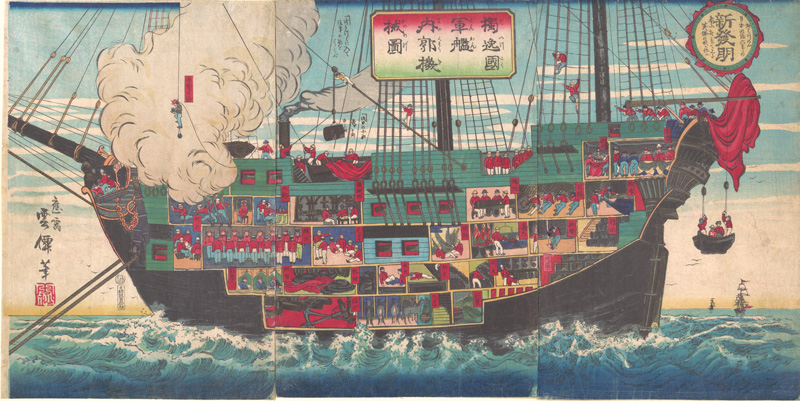Biographical Data
Biography
Unsen 雲僊 うんせん (active c. 1874)
It is unclear whether this Meiji era artist who signed his name Unsen using the characters 雲僊 on the few extant triptychs attributed to him is the same person as the Meiji era painter Koyama Unsen 小山雲泉(1855-1911) who used the characters 雲泉 in his signature. I have come across three extant woodblock triptychs bearing the 雲僊 signature, the most famous of which being a depiction of the interior of a German battleship, shown below.
[ 独逸国軍艦内廓機械図 Doitsugokūkan naibu kikai]
The signature of the painter Koyama Unsen using the characters 雲泉 is seen on a number of painted scrolls depicting landscapes and still-lifes which are dated to the late-Edo period, but there is also reference to a Koyama Unsen 小山雲泉 in the 1893 official directory of the World’s Columbian Exposition under the heading “Engravings and Etchings, Prints” which would have included woodblocks.1 In addition, Andreas Marks lists a Koyama Unsen 小山雲泉 as a contributor of “additional images and descriptions” to the 1872 series Shoga gojusan tsugi (Paintings and Writings Along the Fifty-three Stations), whose primary designer was Utagawa Yoshitori (1797-1861).2 A Koyama Unsen who edited a book of seal inscriptions in 1886 may be the same Koyama Unsen as the scroll painter. (See Signatures and Seals below.) A comparison of seals and signatures of both the above Unsens is provided below.
The two English language references I found for Unsen the triptych designer provide little information, stating that “Unsen, an artist who it otherwise totally unknown, was specially commissioned to draw a cross section of a German battleship in 1874”3 and that Unsen 雲僊 (fl. c. 1875) was a printmaker who “specialized in the depiction of Western mechanical inventions, particularly Western ships.”4
Neither of the Unsens discussed above should be confused with the earlier artist named Kushiro Unsen
釧雲泉 (1758(9)-1811), a painter in the nanga (Southern Chinese painting) tradition.
1 The Official Directory of the World's Columbian Exposition, May 1st to October30th, 1893: A Reference Book of Exhibitors and Exhibits, and of the Officersand Members of the World's Columbian Commission..., ed. Moses P. Hand, W.B. Conkey Co., 1893, p. 979.
2 Kunisada’s Tōkaidō Riddles in Japanese Woodblock Prints, Andreas Marks, Brill, 2013, p. 52.
The Two Unsens - Signatures and Seals
Signatures and Seals attributed to Unsen 雲僊
 應需雲僊筆 ōju Unsen hitsu sealed ?印雲僊 |  ōju Unsen hitsu with Unsen seal |  Unsen ? with unread seal |  Unsen ga with unread seal |  Unsen hitsu |
Signatures and seals attributed to Koyama Unsen 小山雲泉
 Unsen hitsu |  雲泉筆 Unsen hitsu | 小山雲泉 signature and seal from the colophon of a four volume book of seals titled 千字文百顆韵譜 dated May 1886 |
2 Kunisada’s Tōkaidō Riddles in Japanese Woodblock Prints, Andreas Marks, Brill, 2013, p. 52.
3 The World of the Meiji Print: Impressions of a New Civilization, Julia Meech-Pekarik, Weatherhill, 1986
Yokohama Prints from Nineteenth-Century Japan, Yonemura, Smithsonian Institution, 1990, p. 99.
Yokohama Prints from Nineteenth-Century Japan, Yonemura, Smithsonian Institution, 1990, p. 99.
4 A Dictionary of Japanese Artists: Painting, Sculpture, Ceramics, Prints, Lacquer, Laurance P. Roberts, Weatherhill, 1976, p. 192.


